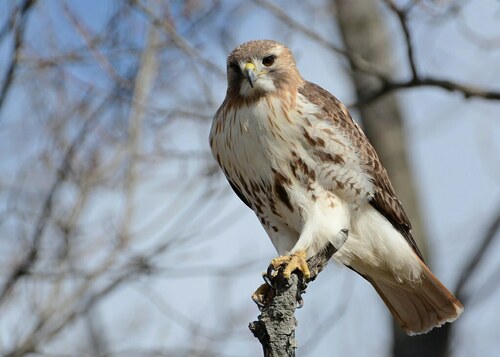
Red-tailed Hawk
The Red-tailed Hawk (Buteo jamaicensis) is one of the most widespread and recognizable raptors in North America. Known for their keen eyesight and broad, rounded wings, these birds of prey play a crucial role in controlling rodent populations. They are adaptable, found in diverse habitats, and are often seen soaring high above open fields or perched on telephone poles. While not culturally significant in the same way as some eagles, the Red-tailed Hawk is a symbol of strength and resilience, frequently featured in artwork and literature.
45-65 cm
Length
110-145 cm
Wingspan
Least Concern
Conservation Status
Distribution
Red-tailed Hawks are found throughout North America, ranging from Alaska and Canada down to Panama and the West Indies. They exhibit some migratory behavior, with northern populations moving south for the winter. Their altitudinal range extends from sea level to high mountain slopes.
Lifespan
In the wild, they can live up to 20 years or more, with some individuals reaching 30 years in captivity.
Red-tailed Hawk's Habitat
Habitat Types
Open woodlands, Grasslands, Deserts, Farmlands, Urban areas
Climate Zones
Temperate, Tropical, Subarctic
Adaptations
Their broad wings and soaring flight are well-suited for open habitats, allowing them to conserve energy while hunting. Their exceptional eyesight allows them to spot prey from great distances.
Variations
There are several recognized subspecies, differing slightly in size and plumage. For example, the 'Harlan's Hawk' (B. j. harlani) is a darker variant found in Alaska and northwestern Canada.
Appearance
Breeding Plumage
Adult plumage is relatively consistent year-round, though it may appear slightly more worn in non-breeding season.
Seasonal Feather Changes
Minimal seasonal variation in adults.
Sex Based Plumage Differences
Adult males and females have similar plumage, although females may have slightly more barring on the belly.
Notable Features
Reddish-brown tail (in adults), Dark brown back and upper wings, Pale underparts with a dark belly band, Strong, hooked beak, Powerful talons
Diet and Feeding
Primary Foods
Small mammals (rodents, rabbits), Birds, Reptiles, Amphibians, Invertebrates
Foraging Behavior
Red-tailed Hawks primarily hunt from a high perch or while soaring. They use their keen eyesight to spot prey, then swoop down to capture it with their talons.
Specializations
Their sharp talons and powerful beak are adapted for capturing and consuming a variety of prey.
Seasonal Diet Variations
Diet may vary depending on prey availability. For example, they may consume more birds during migration periods or more insects during summer months.
Behavior
Social Structure
Red-tailed Hawks are generally solitary or found in pairs, especially during the breeding season. They may form loose aggregations during migration.
Communication
Vocalizations (a high-pitched 'kee-eee-arr' scream), Aerial displays, Body postures
Migration
Northern populations are migratory, while southern populations may be resident year-round. Migration routes and timing vary depending on location.
Territorial or Group Behaviors
Red-tailed Hawks are highly territorial, especially during the breeding season. They defend their territories against other hawks and potential predators.
Conservation
Threats
Habitat loss, Collisions with vehicles, Electrocution on power lines, Exposure to pesticides and rodenticides
Protection Programs
Migratory Bird Treaty Act, Endangered Species Act (in some regions)
Local National Laws
Protected under various state and federal laws in the United States and Canada.
Population Trend
Stable
Population Estimates
The global population is estimated to be in the millions.
Interesting Facts
Red-tailed Hawks have exceptional vision.
Their eyesight is estimated to be eight times better than that of humans, allowing them to spot prey from great distances.
They can reach speeds of up to 120 mph during a dive.
This incredible speed is used when hunting prey.
The call of the Red-tailed Hawk is often used in movies as the sound of an eagle.
This is because its scream is more powerful and dramatic than the actual call of the Bald Eagle.
Faqs about Red-tailed Hawk
What is the biggest threat to Red-tailed Hawks?
Historically, shooting was a major threat, but now habitat loss and secondary poisoning from rodenticides are significant concerns.
How can I tell a male Red-tailed Hawk from a female?
It's difficult to distinguish them visually, but females are generally larger than males.
Do Red-tailed Hawks mate for life?
They are generally monogamous and may maintain pair bonds for several years, but if one partner dies, the other will seek a new mate.
Copyright @ Nature Style Limited. All Rights Reserved.
 English
English